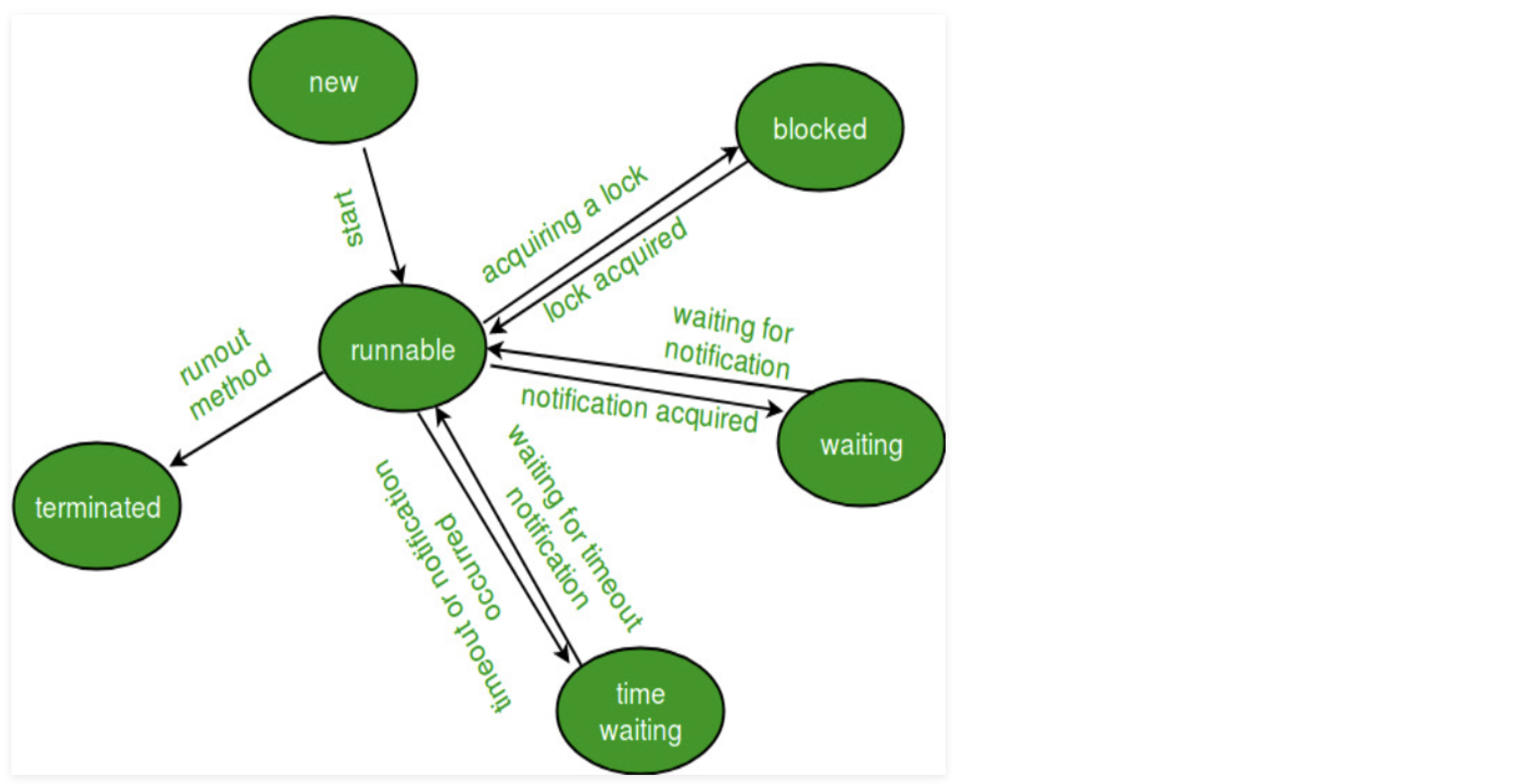您好,登錄后才能下訂單哦!
您好,登錄后才能下訂單哦!
本篇內容主要講解“Java中線程及線程狀態是什么意思”,感興趣的朋友不妨來看看。本文介紹的方法操作簡單快捷,實用性強。下面就讓小編來帶大家學習“Java中線程及線程狀態是什么意思”吧!
線程(英語:thread)是操作系統能夠進行運算調度的最小單位。它被包含在進程之中,是進程中的實際運作單位。一條線程指的是進程中一個單一順序的控制流, 一個進程中可以并發多個線程,每條線程并行執行不同的任務。在Unix System V及SunOS中也被稱為輕量進程(lightweight processes), 但輕量進程更多指內核線程(kernel thread),而把用戶線程(user thread)稱為線程。
以上拷貝自維基百科
代碼中任務、邏輯操作都依賴于線程,是java運行時最寶貴的資源
多線程一定程度可以增加cpu使用時間,壓榨計算機資源提供更好的使用性能,一定程度也增加了資源的消耗如內存的增長、線程上下文數據切換的消耗、cup資源消耗,實際情況中我們應該根據業務場景合理的使用線程資源
 

https://www.geeksforgeeks.org/lifecycle-and-states-of-a-thread-in-java/contribute.geeksforgeeks.org/wp-content/uploads/threadLifeCycle.jpg
java.lang.Thread.State 定義了如下6種線程狀態
/**
* Thread state for a thread which has not yet started.
*/
NEW,
/**
* Thread state for a runnable thread. A thread in the runnable
* state is executing in the Java virtual machine but it may
* be waiting for other resources from the operating system
* such as processor.
*/
RUNNABLE,
/**
* Thread state for a thread blocked waiting for a monitor lock.
* A thread in the blocked state is waiting for a monitor lock
* to enter a synchronized block/method or
* reenter a synchronized block/method after calling
* {@link Object#wait() Object.wait}.
*/
BLOCKED,
/**
* Thread state for a waiting thread.
* A thread is in the waiting state due to calling one of the
* following methods:
* <ul>
* <li>{@link Object#wait() Object.wait} with no timeout</li>
* <li>{@link #join() Thread.join} with no timeout</li>
* <li>{@link LockSupport#park() LockSupport.park}</li>
* </ul>
*
* <p>A thread in the waiting state is waiting for another thread to
* perform a particular action.
*
* For example, a thread that has called <tt>Object.wait()</tt>
* on an object is waiting for another thread to call
* <tt>Object.notify()</tt> or <tt>Object.notifyAll()</tt> on
* that object. A thread that has called <tt>Thread.join()</tt>
* is waiting for a specified thread to terminate.
*/
WAITING,
/**
* Thread state for a waiting thread with a specified waiting time.
* A thread is in the timed waiting state due to calling one of
* the following methods with a specified positive waiting time:
* <ul>
* <li>{@link #sleep Thread.sleep}</li>
* <li>{@link Object#wait(long) Object.wait} with timeout</li>
* <li>{@link #join(long) Thread.join} with timeout</li>
* <li>{@link LockSupport#parkNanos LockSupport.parkNanos}</li>
* <li>{@link LockSupport#parkUntil LockSupport.parkUntil}</li>
* </ul>
*/
TIMED_WAITING,
/**
* Thread state for a terminated thread.
* The thread has completed execution.
*/
TERMINATED;New:剛創建,可被執行,并且未開始執行
Runnable:正在執行或隨時準備執行,例如多線程程序分配特定時間片給特定線程,特定線程執行短暫時間并暫停放棄cpu時間給其他線程,其他線程因此可以執行,這種場景線程是準備執行等待CPU時間,這種狀態即Runnable
Blocked:waiting for a monitor lock,處于需要獲取其他線程鎖定的同步資源,如等待io結束,這種狀態在轉變為Runnable之前無法執行,無法消耗cup時間片
Waiting:等待其他線程執行特定操作,和Blocked類似
Timed Waiting:線程調用等待執行場景,特定時間后執行,比較sleep,或者一些條件等待場景,如定時任務
Terminated:正常或異常結束線程,將不分配CPU時間
1線程狀態轉換
public class DemonstrateThreadStates2 {
static Thread thread1;
public static void main(String[] args) {
//創建線程1
thread1 = new Thread(new TestThread1());
// thread1 創建后 NEW state.
System.out.println("State of thread1 after creating it - ">控制臺輸出:
State of thread1 after creating it - NEW State of thread1 after calling .start() method on it - RUNNABLE State of thread2 after creating it - NEW State of thread2 after calling .start() method on it - RUNNABLE State of thread2 after calling .sleep() method on it - TIMED_WAITING State of thread1 while it called join() method on thread2 -WAITING State of thread2 when it has finished it's execution - TERMINATED
線程創建線程變成NEW狀態,調用start啟動線程變成Runnable,調用sleep阻塞當前線程吧變成Timed Waiting,thread2調用join將等待結束當前線程到父線程thread1,thread2線程將變成die,父線程thread1 等待線程thread2結束變成waiting
2模擬blocked場景
通過死鎖模擬blocked場景
死鎖條件
互斥使用:一個資源只能分配給一個線程
不可剝奪:資源只能由占有者釋放,申請者不能強制剝奪
請求保持:線程申請資源時,保持對原有資源的占有
循環等待:存在一個進程等待隊列:{P1 , P2 , … , Pn}, 其中P1等待P2占有的資源,P2等待P3占有的資源,…,Pn等待P1占有的資源,形成一個進程等待環路
代碼public class TestDeadLock implements Runnable {
// flag=1,占有對象o1,等待對象o2
// flag=0,占有對象o2,等待對象o1
public int flag = 1;
// 定義兩個Object對象,模擬兩個線程占有的資源
public static Object o1 = new Object();
public static Object o2 = new Object();
public static void main(String[] args) {
TestDeadLock deadLock1 = new TestDeadLock();
TestDeadLock deadLock2 = new TestDeadLock();
deadLock1.flag = 0;
deadLock2.flag = 1;
Thread thread1 = new Thread(deadLock1);
Thread thread2 = new Thread(deadLock2);
thread1.start();
thread2.start();
}
@Override
public void run() {
System.out.println("flag: " + flag);
// deadLock2占用資源o1,準備獲取資源o2
if (flag == 1) {
synchronized (o1) {
try {
Thread.sleep(1000);
} catch (InterruptedException e) {
e.printStackTrace();
}
synchronized (o2) {
System.out.println("1");
}
}
}
// deadLock1占用資源o2,準備獲取資源o1
else if (flag == 0) {
synchronized (o2) {
try {
Thread.sleep(1000);
} catch (InterruptedException e) {
e.printStackTrace();
}
synchronized (o1) {
System.out.println("0");
}
}
}
}
}https://www.geeksforgeeks.org/lifecycle-and-states-of-a-thread-in-java/
https://www.jianshu.com/p/8cf78bf94f9d
到此,相信大家對“Java中線程及線程狀態是什么意思”有了更深的了解,不妨來實際操作一番吧!這里是億速云網站,更多相關內容可以進入相關頻道進行查詢,關注我們,繼續學習!
免責聲明:本站發布的內容(圖片、視頻和文字)以原創、轉載和分享為主,文章觀點不代表本網站立場,如果涉及侵權請聯系站長郵箱:is@yisu.com進行舉報,并提供相關證據,一經查實,將立刻刪除涉嫌侵權內容。